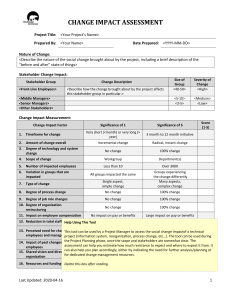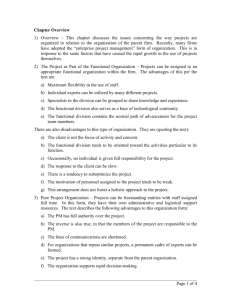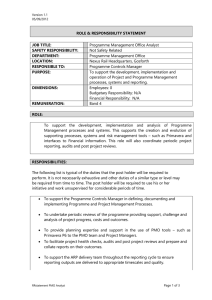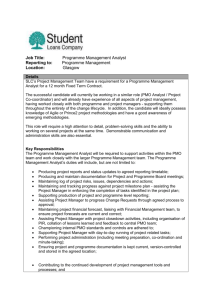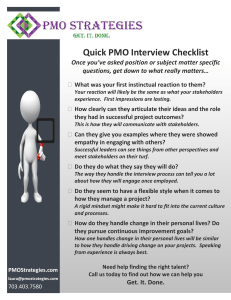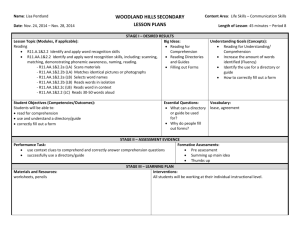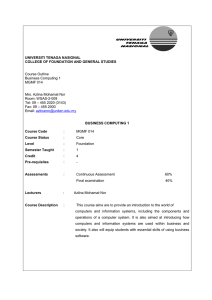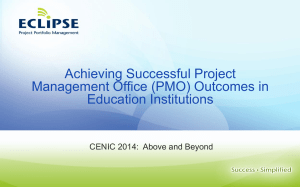Ch 2: Project Selection
advertisement
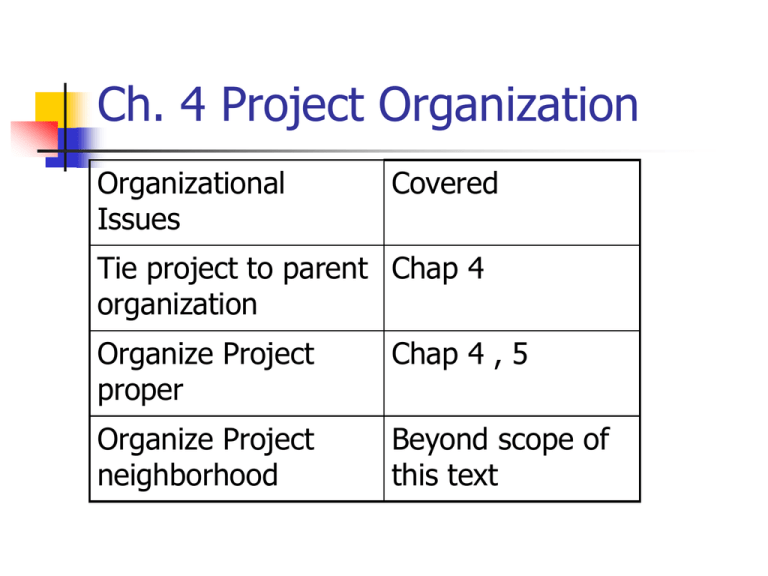
Ch. 4 Project Organization Organizational Issues Covered Tie project to parent Chap 4 organization Organize Project proper Chap 4 , 5 Organize Project neighborhood Beyond scope of this text Ch 4.0: Four Drivers of Project Management Growth Speed to market Complexity and uniqueness of new inventions Disturbances/expansions of the enterprise Accountability of non-routine tasks Ch. 4.0 Chapter Sections Hybrid project/functional organization Pure project organization Matrix organization Choosing an organizational form The project team Human factors and the project Ch. 4.1 Hybrid Project / Functional Organization University of Cincinnati organization chart Ch 4.1: Advantages of Hybrid Organization Highly flexible staff use Ease of switching experts among projects in same functional division Specialist pooling in functional division Technological continuity Quicker career advancement of specialists Ch 4.1: Disadvantages of Hybrid Organization Project not client focused Different goals between functional parent division and project PM competes with FM for role of central project responsibility Slow response to client needs Sub-optimization along parent functional division needs Weaker project team motivation than in pure project organization Not a holistic approach to project management Ch 4.2: Pure Project Organization Ch 4.2: Advantages of Pure Project Organization PM with full project authority Team directly responsible to PM Shorter communication lines than hybrid organization Skill pools of technical experts Higher project commitment of team Faster decision making Unity of command makes life easier for staff Organization is structurally simple and flexible Holistic approach to project management Ch 4.2: Disadvantages of Pure Project Organization Duplication of staff among projects Stockpiling of expertise and equipment to assure critical state never reached Experts develop too much depth --- not enough breath Inconsistency in carrying out policies and procedures Projectitis: excessive attachment of team to project Team worries of “life after the project ends” Ch. 4.3: The Matrix Organization Ch. 4.3: From Project Emphasis to Functional Emphasis Project Functional PM role Emphasis Division provides Strong People Controls people individually Balanced Functional Units Controls functional units Weak Coordinates project activities Capacity Ch. 4.3: Matrix Organization Advantages PM sole responsible for project managing Access to entire technology of firm No worry about “life after project” Rapid response to client need Consistent with policies, procedures of parent firm Company wide sharing of resources Flexible between “weak” and “strong” matrix organization Ch. 4.3 Matrix Organization Disadvantages Political infighting: PM against FM Political infighting: PM against PM Projects resist shutdown Over reliance on negotiating skills of PM No unity of command Ch. 4.4: Mixed Organizational Systems (I) Coexistence of pure project and functional organization to form a mixed system Ch. 4.4: Mixed Organizational Systems (II) Addition of Project staff office to form a mixed system Ch. 4.5: Choosing an Organizational Form Organizational Project type form Technology type Functional Large capital investment In-depth Matrix Integration of Reasonably functional areas complex Pure Project Many similar projects Routine or highly unique Ch 4.5: Choosing an Organizational Form Define outcome (goals) of project Find “functional home” closest associated with key tasks Sequence and decompose key tasks into “work packages” Assign appropriate organizational units to “work packages” Consider any special project characteristics or assumptions Choose a project structure Ch 4.5: Project Management in Practice (Caltrans) Create project management office (PMO) CULTIVATE (not designate!) PMs Use outside resources and help Develop a uniform work breakdown structure Create EMPOWERED project management forums Use requirement analysis to select project management software INVOLVE (not placate!) Top management Ch 4.6: Risk Management Sub-processes Risk management planning Risk identification Qualitative risk analysis Quantitative risk analysis Risk response planning Risk monitoring and control PMBOK® guide, 2000 edition Ch. 4.6: Makeup of Sample Risk Management Group (RMG) for New Product Development Scientist familiar with new product Market specialist Manufacturing specialist Product safety expert Patent attorney Manager (program and/or HR) Government relations expert Ch 4.6: Contents of Risk Management Knowledge Base All possible project environments All risk factors identified in previous projects All risks identified by RMG All “categories” and “key words” to identify risk All qualitative and quantitative risk estimates for the project Minutes (including action items) of all RMG meetings Actual outcome of all estimated project risks Ch 4.6: Risk Evolution Along Project Life Cycle Feasibility: external risks, tied to overall state of the technology Planning: internal risks, tied to specific project technology Ch. 4.6: Project Management Office (PMO) Statistics Founded before ‘97 Govt. 75% Public 15% All All # Employees # Projects >1000 >300 <300 >11 80% 10% >40 10% 67% 25% Ch. 4.6: Reasons for Initiating PMOs 65%: need for consistent project management 50%: avoid project delays and help with planning 40%: contain cost, improve project performance 25%: improve customer satidfaction Ch. 4.6: PMO Level of Service Offered 78% 64% 58% 50% 50% 28% follow standard project processes consulting help on projects training and mentoring project tracking risk portfolio management maintain pool of PMs Ch. 4.6: Strategic Reasons for Establishing PMOs Alignment of project goals with organizational goals Gradual assimilation of good project management practices Cultural change from functionally managed organization to project oriented organization Ch. 4.6: Why Organizations Establish PMO’s To establish and keep good project management processes To distribute project management expertise through organization To improve project success rate To reduce project lead times To consolidate project data To own an “enterprise project management” system Ch. 4.6: PMO Tasks (I) 1. 2. 3. 4. 5. Establish and enforce good project management processes Assess/improve organizations project management maturity Acquire enterprise project management system Train and certify PMs Cultivate competent PMs Ch. 4.6: PMO Tasks (II) 6. 7. 8. 9. 10. 11. Consulting services for company PMs Help PMs with administrative details Risk evaluation Product “fit” for organization Monitor market changes and alert PMs of potentially needed scope changes Review and limit organizations OVERALL project risk portfolio Ch. 4.6: PMO Tasks (III) 12. 13. 14. 15. 16. 17. Audits and project reviews Keep project management database Help launch new projects Recognize and reward project management excellence “Home” for PMs Disseminate project management knowledge Ch. 4.6: Timetable for Implementing PMO Tasks Timeframe PMO tasks First few months 1., 7., 16. First year 2., 3., 5., 8., 9., 14., 15. Long term 4., 6., 10., 11., 12., 13., 17. Ch. 4.6: Completeness of PMO Completeness PMO tasks Lower level 2. Middle level 1., 4., 5., 6., 7., 8., 13., 16. Upper level 3., 9., 10., 11., 12., 14., 15., 17. Ch. 4.6: PMO Tasks As a Function of Reporting Level Reporting level PMO tasks FM (IT or Engineering) 5., 6. VP (business level) 1., 4., 16. CEO (strategic level) 2., 3., 7., 8., 9., 10., 11., 12., 13., 14., 15., 17. Ch. 4.6: How to Build a PMO Get backing and sponsorship from senior management (VP or at least FM) Pilot project in VP/fm’s area of control In second iteration, expand PMO to cover the whole organization PMO will self propagate due to it’s usefulness Ch. 4.6: Potential PMO Problems Unrealistic expectations: PMO may not save a project already in trouble PMO cannot correct upper management failures such as: Inflated project goals Insufficient project support Inadequate resource availability Ch. 4.7 Project Team Key Staff Project engineer (design / analysis) Manufacturing engineer (production) Field manager (at customer site) Contract administrator (paperwork) Project controller (cost) Support services manager (subcontracts) Ch. 4.7: Typical Organization for Engineering Projects Ch. 4.7: How to Staff a Project Team Break down work structure into tasks Assess skills needed for each task Recruit skilled workers from functional departments Negotiate with employee AND FM to get worker for project If no local skill available subcontract! Ch. 4.7: Team Members Who Report to PM or Deputy PM Project engineer (often the deputy PM) Senior project team members Members who require close communication with PM Members with essential, rare skills Ch. 4.7: Weak Matrix Team Building One or two skilled full time team members “Capacity” from functional divisions Several project components supplied by functional divisions in the form of deliverables Ch. 4.8: Human Factors in Meeting Deadlines Delivering adequate – not perfectionist - work quality saves time Team members motivated by: Recognition Achievement Work itself Responsibility Advancement Chance to learn new skill Ch. 4.8: Recently Popular Project Management Styles Management By Objective (MBO) workers take responsibility for tasks Continuous Improvement Teams (CIT) Total Quality Management (TQM) Self Directed Teams (SDT) Ch. 4.8: Empowerment of Project Teams - Advantages Lets team members manipulate tasks so objectives can be met Avoids micromanagement Team members accept responsibility May result in synergistic solutions Timely feedback on performance Empowerment is a tool for PM to evaluate team performance Ch. 4.8: Pillars of Team Building Action plan: also acts as control mechanism Mutual dependency: team members hold each other accountable for reaching goals Ch. 4.8: Essential Company Support for Team Building Effective rewards Individual and team performance feedback Individual and team goal setting Ch. 4.8: Conflict Sources in the EARLY Stages of the PLC Project Formation: Priorities clearly define plans Procedures develop a charter Schedules early schedule development Building Phase: Priorities status review sessions Schedules work breakdown packages Procedures contingency planning Ch. 4.8: Conflict Sources in the LATE Stages of the PLC Main Program: Schedules continuous monitoring of work Technical early resolution of problems Labor early staffing forecasts Phaseout: Schedules close schedule monitoring Personality loosen up high stress situations Labor reallocate staff upon end of project Ch. 4.8: Number of Conflicts During a Sample Project Phase of Project Start Early Main 27 35 24 26 27 15 18 26 31 21 25 25 20 13 15 25 29 36 16 19 15 Late 16 9 11 17 11 30 17 Sources of Conflict Project priorities Admin procedures Technical tradeoffs Staffing Support cost estimates Schedules Personalities Ch. 4.8: Conflict Intensity Along Project Life Cycle Ch. 4.8: The Name-Only-Team (NOT) PM: conflict avoider compromise rarely solves problems Team members: discipline oriented individuals prone to political infighting Result: workgroup math is 2+2=3 or less! Ch. 4.8: Conflict Management PM encourages openness PM sets role model in conflict resolution PM harnesses energy of conflict When outside pressure too high, avoid face-to-face meetings

